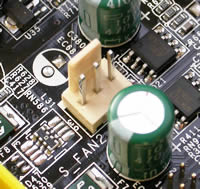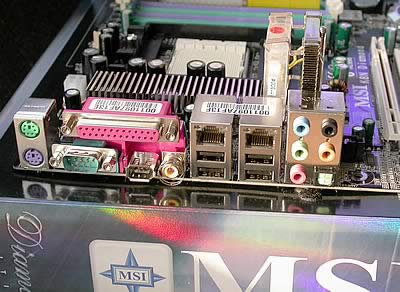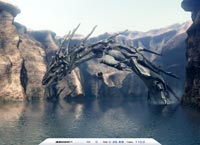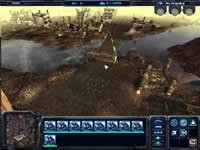1. Introduction
 Micro-Star International is one of the leading board manufacturers world-wide. Founded in 1986, the philosophy of the company is "to offer Award-winning product quality and outstanding customer service". Apart from mainboards, MSI manufactures add-on cards, servers/workstations, barebones, optical storage devices,
communications devices and IA accessories.
Micro-Star International is one of the leading board manufacturers world-wide. Founded in 1986, the philosophy of the company is "to offer Award-winning product quality and outstanding customer service". Apart from mainboards, MSI manufactures add-on cards, servers/workstations, barebones, optical storage devices,
communications devices and IA accessories.
 The MSI K8N motherboard was one of the first mainboards to utilize NVidia's nForce4 MCP, offering SLI support for outstanding graphics experience. There is a Platinum edition and a Diamond edition. The main differences between these two is that the Diamond edition supports more SATA drives. There is also an optional WiFi-Bluetooth add-in card. CDRinfo will be testing the MSI K8N Diamond (with no WiFi-Bluetooth card) in this review.
The MSI K8N motherboard was one of the first mainboards to utilize NVidia's nForce4 MCP, offering SLI support for outstanding graphics experience. There is a Platinum edition and a Diamond edition. The main differences between these two is that the Diamond edition supports more SATA drives. There is also an optional WiFi-Bluetooth add-in card. CDRinfo will be testing the MSI K8N Diamond (with no WiFi-Bluetooth card) in this review.
- Features
The complete list of all features that the K8N SLI Diamond motherboard offers can be seen below.
  Supports AMD Socket 939 Athlon 64FX/Athlon 64, which are based on AMD's 64-bit and 32-bit architecture. Supports AMD Socket 939 Athlon 64FX/Athlon 64, which are based on AMD's 64-bit and 32-bit architecture. |
  The NVIDIA nForce4 Scalable Link Interface (SLI) technology will let you work with two identical graphic boards and combine their processing power. The NVIDIA nForce4 Scalable Link Interface (SLI) technology will let you work with two identical graphic boards and combine their processing power. |
 Active MOS is proven to be able to lower components temperature on a motherboard, including those of inductors, PWM IC and capacitors. By lowering temperature of the components, the life span of a motherboard is extended. Active MOS is proven to be able to lower components temperature on a motherboard, including those of inductors, PWM IC and capacitors. By lowering temperature of the components, the life span of a motherboard is extended. |
 Fast ATA133 controllers will work in high transfer speed, with PIO, Bus Master and Ultra DMA133/100/66 operation modes.. You can connect up to 4 IDE devices Fast ATA133 controllers will work in high transfer speed, with PIO, Bus Master and Ultra DMA133/100/66 operation modes.. You can connect up to 4 IDE devices |
 AMD's Cool'n'Quiet technology will ensure that the CPU will run at high speed only when it is needed. By reducing the operating frequency of the CPU when there are low CPU demands, the CPU will run at lower temperature, eliminating crashes and blue screens. AMD's Cool'n'Quiet technology will ensure that the CPU will run at high speed only when it is needed. By reducing the operating frequency of the CPU when there are low CPU demands, the CPU will run at lower temperature, eliminating crashes and blue screens. |
 
CoreCell is composed of 4 features:
Speedster (Maximum Overclocking),PowerPro (powersaving), LifePro (constant temp control, smart FAN ) and BuzzFree (noise management). It allows user to clearly understand the system info from AP and BIOS.
CoreCenter merges MSI features--FuzzyLogic and PC Alert. It provides user more advanced overclocking options by extending the Voltage
selection, increasing the frequency adjustable range CPU/AGP/DDR/PCI. It monitors every temperature inside the system, control it according to system
current loading and need. |
  There are two LAN connectors on board. One by nForce4 SLI chipset and one by Marvell 88E8053. You can now work with up to 1Gb connection speed. There are two LAN connectors on board. One by nForce4 SLI chipset and one by Marvell 88E8053. You can now work with up to 1Gb connection speed. |
 MSI chooses Creative chipsets as the on-board sound device. This is a feature not easily seen on AMD mainboards. You will surely enjoy exceptional sound quality. The SoundBlaster Live! 24-bit chipset supports up to 7.1 CH Surround Sound, and is Dolby Digital ready. MSI chooses Creative chipsets as the on-board sound device. This is a feature not easily seen on AMD mainboards. You will surely enjoy exceptional sound quality. The SoundBlaster Live! 24-bit chipset supports up to 7.1 CH Surround Sound, and is Dolby Digital ready. |
  The nForce4 chipset offers up to 10 USB2.0 ports, while the VIA 6306 chipset offers up to three IEEE1394 ports. The nForce4 chipset offers up to 10 USB2.0 ports, while the VIA 6306 chipset offers up to three IEEE1394 ports. |
 The ultimate combo of MSI™ exclusive Live BIOS™, Live Driver™, Live Utility ,Live Monitor. With Live Update 3, you can update online BIOS/Driver/Utility. Live Monitor auto-detects and suggests the latest BIOS/Driver/Utilities
information. The ultimate combo of MSI™ exclusive Live BIOS™, Live Driver™, Live Utility ,Live Monitor. With Live Update 3, you can update online BIOS/Driver/Utility. Live Monitor auto-detects and suggests the latest BIOS/Driver/Utilities
information. |
  The nForce4 SLI chipset adds four SATA II ports (RAID 0 or 1, 0+1, JBOD is supported, up to 4 SATA + 2 ATA133 Hard drives), and the Silicon Image chipset offers two more SATA II ports (RAID 0 or 1, JBOD groups and multiple RAID). The nForce4 SLI chipset adds four SATA II ports (RAID 0 or 1, 0+1, JBOD is supported, up to 4 SATA + 2 ATA133 Hard drives), and the Silicon Image chipset offers two more SATA II ports (RAID 0 or 1, JBOD groups and multiple RAID). |
 The mainboard supports up to 4 184-pin DDR DIMMs, that can operate in Dual-mode to boost performance. Maximum memory size supported is 4GB. The mainboard supports up to 4 184-pin DDR DIMMs, that can operate in Dual-mode to boost performance. Maximum memory size supported is 4GB. |
You can see the complete specification table below:
| CPU |
• Supports Socket 939 for AMD® Athlon™ 64 FX / Athlon™ 64 processor
• Supports up to 3500+, 3800+ Athlon 64 FX 53, or higher CPU
|
| Chipset |
NVIDIA nForce®4 SLI™ |
| Front Side Bus |
2000 MT/s, 1600MT/s |
| Memory |
• Supports dual channel DDR 266/333/400, using four 184-pin DDR DIMMs.
• Supports a maximum memory size up to 4GB.
• Supports 2.5v DDR SDRAM DIMM. |
| Expansion Slots |
• Two PCI Express x16 slot (supports PCI Express Bus specification v1.0a compliant)
• Two PCI Express x1 slots (by share) (support PCI Express Bus specification v1.0a compliant)
• Three 32-bit v2.3 Master PCI bus slots (support 3.3v/5v PCI bus interface). |
| SLI |
- Under SLI mode : support two identical SLI-ready graphics cards (x8)
- Under Default(Single VGA) mode: supports all PCI Express graphics cards (x16)
|
| Storage/ RAID |
• NV RAID supports 4 SATA II ports(SATA 1 to 4). Transfer rate is up to 300MB/s.
• Silicon Image's SATA RAID supports another 2 SATA II ports. Transfer rate is up to 300MB/s.
NV RAID (Software)
• Supports up to 4 SATA + 2 ATA133 Hard drives
- RAID 0 or 1, 0+1, JBOD is supported
- RAID function available for ATA133 + SATA HD drives or 2 SATA HD
Silicon Image's SATARAID™ (Software)
• RAID 0 or 1, JBOD groups and multiple RAID are supported
• Support up to 2 SATA devices connected to a single controller
- Two independent SATA controllers, for four drives
- Dual Fast ATA-133 IDE controllers
- IEEE 802.3 NVIDIA MAC for 1000BASE-T
(An IDE controller on the NVIDIA nForce4 SLI chipset provides IDE HDD/CD-ROM with
PIO,
Bus Master and Ultra DMA133/100/66 operation modes) |
| LAN |
• Supports dual LAN jacks
- 1st LAN supports 10/100/1000 Fast Ethernet by nForce4 SLI
- 2nd PCI Express LAN supports 10/100/1000 Fast Ethernet by Marvell 88E8053 |
| Audio |
• Creative sound Blaster Live 24-bit onboard audio
- 24-bit / 96KHz audio quality
- 100db SNR clarity
- Up to 7.1 CH Surround Sound, Dolby Digital ready |
| IEEE 1394 |
• VIA 6306 chipset
- Supports up to three 1394 ports. (Rear panel x1, front x2)
- Transfer rate is up to 400Mbps |
| USB |
Max. 10 USB2.0 ports |
| On-Board Peripherals |
- 1 floppy port supports 2 FDD with 360K, 720K, 1.2M, 1.44M and 2.88Mbytes
- 1 serial port
- 1 parallel port supports SPP/EPP/ECP mode
- 1 Audio jack(5-in-1), coaxial/fiber SPDIF out
- 1 IrDA pinheader
- 1 D-Bracket2 pinheader
- 10 USB 2.0 ports (Rear x 4 / Front x 6)
- 2 RJ45 LAN jacks
- 3 IEEE 1394 connectors (Rear x 1/ Front x 2) |
| BIOS |
• The mainboard BIOS provides "Plug & Play" BIOS which detects the peripheral devices and
expansion cards of the board automatically.
• The mainboard provides a Desktop Management Interface(DMI) function which records your
mainboard specifications.
|
| Dimension |
30.4cm(L) x 24.4cm(W) ATX Form Factor |
| Mounting |
9 mounting holes |
2. A Closer Look
MSI uses a black coloured PCB for this motherboard. Every component and every interface/connection is colour coded in such a way to make it easier to distinguish. Usually, most nForce4 based motherboards have some layout design drawbacks, but in this case, MSI did a great job designing the K8N SLI Diamond, with all the chipsets and connectors appearing to be in the right place.



MSI uses their own patented CoreCell technology, for efficient overclocking, and better temperature control.

A small 4cm fan is used to cool the mainboard's MOFSET. Heat is drawn away from the chipset and the fan cools the metal fins, lowering the temperature. This fan might cause some problems with certain after-sale CPU coolers, especially those using 120mm fans.

Another 4cm fan is used on the nForce4 chipset. Again, as quiet as possible. This fan's rotation speed is approximately 7500RPM.

This is where the CPU resides. You can clearly see the distance between the 4cm MOFSET fan (Active MOS2) and the CPU. The capacitors that are near the CPU are very small, and you will not have any problem if you want to get rid of the stock cooler and get that nice looking huge heatsink you always wanted.

On the board, you will find two 3-pin fan connectors, one for the CPU fan and one located in the center of the mainboard for additional HD or case cooling.


The memory module slots are colour coded green and purple. Like all modern mainboards, if you want to enable Dual Channel's symmetry mode, you should use two memory modules of the same size in the same slot colour.

On the back panel, you will find the audio ports, parallel port, serial port, keyboard and mouse ports, one IEEE1394 port, 4 USB2.0 ports and two RJ-45 LAN jacks.

The yellow connectors shown below are six additional USB2.0 connectors (2X3 USB2.0), and the green connectors are two additional IEEE1394 connectors. If your case has USB2.0 and IEEE1394 ports on the front panel, you can use these connectors to provide these ports.

The purple connectors are for Serial ATA devices.

The MSI K8N Diamond uses an SLI selector card to enable SLI mode. You should set this card accordingly, depending on whether you want to work in Single VGA mode or in Dual VGA mode.

The Creative CA0106 chipset is the same chipset used in the Creative SoundBlaster Live! cards. Exceptional sound experience is one of the benefits of this board. This small chipset offers 7.1 CH Surround Sound, and Dolby Digital support.

There are two LAN jacks on this motherboard. One is powered by the nForce4 chipset, and the other is powered by the Marvell 32-bit 88E1111 shown below. It is Yukon's Gigabit Ethernet controller with Integrated PHY.

The VIA VT6306 is a single chip IEEE1394 solution that offers high speed connection.

The Winbond VT6306 chipset monitors temperature and fan rotation speed.

As you can see, this is a well organized motherboard. However, there is a major drawback. The two PCI-E slots are very close to each other, leaving no breathing room between the cards, especially if you install two 6800Ultras with their big coolers taking two PCI slots each. For this review, we ran all tests with two 6600GTs and we had no problems with temperature. We then changed to 2x6800Ultras, and again we had no problem pushing the system to its limits, although we observed slightly higher temperatures.
- The package

MSI has loaded the retail package with a nice set of accessories:






Optionally, you can get a WiFi+Bluetooth card with this motherboard. This can be installed in the red PCI slot, at the bottom of the mainboard:

You also get a user's manual, the Creative drivers disc for the sound card, a drivers disc for all the other components and a nice calendar.
3. Test System - Configuration
As mentioned previously, we used a pair of 6600GTs and a pair of 6800Ultras, but all the graphs shown in this review are with the 6600GTs in action. We compared the MSI K8N Diamond board with the ASUS A8N SLI Premium (AMD64 3500+) and the ASUS P5ND2 SLI Deluxe (Intel P4 3.73Ghz). The Intel CPU is more powerful than the AMD CPU. Keep that in mind when you observe the graphs in this review, because in most cases, the Intel-based motherboard will perform better, but in fact, the powerful 3.73GHz CPU makes the difference, and not the motherboard. You can see our testbed below:
- Processor: AMD64 3500+
- Case: Antec 1080AMG
- Motherboard: MSI K8N Diamond
- Memory: 2x512MB Corsair 400MHz (dual channel)
- VGA Card: 2x nVidia 6600GT (SLI mode)
- Hard Disk Drive: WD800JD 80GB 7200RPM
- DVD Burner: LG GSA-4163B
- Power Supply: EzCool 550Watt
- OS: Microsoft WindowsXP Pro SP2
- DirectX: v9.0c
- nVidia Drivers: version 78.01

Benchmarking Software
3DMark05,03,01
PCMark05
Codecreatures Benchmark Pro
AquaMark3 v3.0
Performance Test V5.0
Farcry v1.3
Half Life 2
Doom 3
Thief 3
Ground Control II
Colin McRae '05
4. 3DMark05
 With 3DMark05, Futuremark continues the tradition in its benchmarking software by providing a state-of-the-art Microsoft ® DirectX ® 9 3D performance benchmark.
With 3DMark05, Futuremark continues the tradition in its benchmarking software by providing a state-of-the-art Microsoft ® DirectX ® 9 3D performance benchmark.
3DMark05 is an all new 3DMark version making the most of Microsoft's DirectX
9. The previous version 3DMark03, did a nice introduction into this level
of technology. However
3DMark03 used DirectX 9 specific features in a limited manner, because fully
supporting hardware was rare at the time of its launch. In contrast, 3DMark05
requires DirectX 9 hardware with full support for at least Shader Model 2,
and takes shader usage to never before seen levels.
Just like its predecessors, 3DMark05's point system is set so that at the
moment of release, the high-end VGA cards available in stores can only score
around 5000 3DMarks, whereas the worst card that meets the programs requirements
yields a score of 1000.
Game Test 1 -Return to Proxycon
 Being the sequel to the "Battle of Proxycon"
from 3DMark03, in "Return to Proxycon" we're once again set in space
and the battle continues as space pirates invade a cargo ship in order to
take control of its valuable cargo.
Being the sequel to the "Battle of Proxycon"
from 3DMark03, in "Return to Proxycon" we're once again set in space
and the battle continues as space pirates invade a cargo ship in order to
take control of its valuable cargo.
This test, tries to simulate a future first-person shooter game with all the high details that entails. The dynamic shadows, high-detailed environment and advanced lighting techniques ensure that under normal circumstances, no recent card can run it with decent frame rates.
Game Test 2 - Firefly Forest
 A forest gets filled with magic fireflies in the night. The moon is nearly full, illuminating the forest with a bluish faint light. The magic fireflies have flickering bright green lights that playfully move around the forest.
A forest gets filled with magic fireflies in the night. The moon is nearly full, illuminating the forest with a bluish faint light. The magic fireflies have flickering bright green lights that playfully move around the forest.
This scene is a nice example of a smaller scale outdoor scene with rich vegetation. Immediate visibility is not so far, and there is a skybox surrounding the whole scene.
A large number of trees with their branches swinging separately, and dense vegetation being dynamically distributed according to the camera movements, make this test the most demanding of the three.
Game Test 3 - Canyon Flight
 A Jules Verne type airship flies through a canyon guarded
by a dangerous sea monster. The airmen defend their ship using heavy cannons,
but these seem to have no effect on the huge sea monster. Finally the crew
manages a narrow escape using the "last resort" afterburners of
the airship.
A Jules Verne type airship flies through a canyon guarded
by a dangerous sea monster. The airmen defend their ship using heavy cannons,
but these seem to have no effect on the huge sea monster. Finally the crew
manages a narrow escape using the "last resort" afterburners of
the airship.
This scene is fairly complex with large areas of water
reflecting the high canyon walls. The water actually is one of the key points
of interest in this scene. The water not only does realistic looking reflections
and refractions, it has a depth fog, making the sea monster swimming under
the airship actually look deep down in the water. The air in this scene also
uses a volumetric fog, making distant cliffs of the canyon really look far
away.

The difference in frame rates is not too great and probably might be mostly due to the different CPUs rather than the motherboards.
Final Score
3DMarks on 3DMark05 are now calculated by the following formula:
(Game Test 1 * Game Test 2 * Game Test 3)^0.33 * 250
This is basically the geometric mean of the total frames in each
game multiplied by 250. This means that all game tests are now equal.

Better performance from the Intel based motherboard.
5. 3DMark03
 3D Mark is a widely used and accepted benchmark that stresses the DirectX performance of a VGA card. A very strong point of 3DMark is that it's VGA card measuring is does not require any CPU power. So the resulting fps are a good reference a VGA card's rendering performance. For testing the performance of each card we used the 4 game benchmarks 3DMark has.
3D Mark is a widely used and accepted benchmark that stresses the DirectX performance of a VGA card. A very strong point of 3DMark is that it's VGA card measuring is does not require any CPU power. So the resulting fps are a good reference a VGA card's rendering performance. For testing the performance of each card we used the 4 game benchmarks 3DMark has.
3Dmark03 also includes sound and CPU tests as well as some other feature tests.
- Game Test 1 - Wings of Fury (DX7)

This test is a combat flight simulator written for older hardware (DirectX 7). Particles are used a lot in this test - smoke and vapor trails, flak and gunfire, and explosions are produced using point sprites and quads.
- Game Test 2 - Battle of Proxycon (DX8)

This test is a simulation of first person shooter game types. 1.1 and 1.4 Vertex shaders are widely used since all character models are skinned using vertex shaders.This makes this test a good vertex shader comparison for VGA cards.
- Game Test 3 - Trolls' Lair (DX8)

This test should be the favorite of all RPG lovers. It is a cut scene of a female warrior facing two malicious trolls. Again the same vertex and pixel processing is used as in game test 2.
This test also uses post-processing effects, such as Depth of Field and Bloom effects which are widely used in today's game cut scene sequences.
- Game Test 4 - Mother Nature (DX9)

Mother nature represents the level of effects and realism that are possible using 2.0 vertex and pixel shaders, plus some other features that DirectX 9 offers.

Except in the GT1 benchmark, in all the rest the A8N motherboard reported high frame rates.
- 3DMark Official score
If you test your machine with 3DMark, you can post the results at 3DMark's online result browser. For more information visit futuremark.com.

6. Codecreatures
 CodeCreatures is a synthetic 3D benchmark that is a good reference for VGA performance comparison. This is a high-end 3D benchmark that also requires DirectX 8 hardware, making a good tool for measuring the potential of DirectX 8 game performance.
CodeCreatures is a synthetic 3D benchmark that is a good reference for VGA performance comparison. This is a high-end 3D benchmark that also requires DirectX 8 hardware, making a good tool for measuring the potential of DirectX 8 game performance.
The Codecreatures benchmark is written with Microsoft's DirectX 8.1 API and incorporates the use of Vertex and PixelShaders popular on next generation 3D accelerators.

The benchmark plays a photo-realistic nature scene and calculates the performance of the graphics adapter by measuring the fps that it can display at 1024x768, 1280x1024 and 1600x1200 resolutions.

-Codecreatures number
The codecreatures number is the resulting score of the total
benchmarking process and is basically the geometric mean of the three frame
rates multiplied by 100.

The numbers speak for themselves...
7. Aquamark/3DMark 2001
 Since the majority of today's applications and games are compatible with DirectX 9, the need of benchmark applications that use DX 9 has been brought up. The benchmark uses the 3D engine (Krass engine) of the Aquanox game.
Since the majority of today's applications and games are compatible with DirectX 9, the need of benchmark applications that use DX 9 has been brought up. The benchmark uses the 3D engine (Krass engine) of the Aquanox game.
Aquamark Triscore
The Aquamark Triscore comprises 3 values: the overall system performance, the performance of the graphics system and the CPU performance. Keep in mind that this is not the total result of the tests, but the result of the whole benchmark process including all 9 chapters.

3DMark 2001
3DMark 2001 is the predecessor to 3DMark03. It's mainly a directx8.1 benchmark and the score depends a lot on the CPU power of your computer. However for reference use only we decided it'd be best to just leave it in our benchmark list so you can compare the next generation cards with the possibly outdated you have at home.

Better performance in both 3DMark01 and Aquamark 3 from the P5ND2-SLI Deluxe motherboard with the Intel CPU. This performance comes close to that of the X850XT graphics card.
8. Half Life 2
Half life 2 is no doubt the most anticipated pc game of all times. Gamers keeping the excellence of Half Life 1 in their mind as well as the remarkable E3 demo preview, have been anxiously waiting for the much delayed release of HL2.
 Characters - Advanced facial animation system delivers the most sophisticated in-game characters ever seen. With 40 distinct facial "muscles," human characters convey the full array of human emotion, and respond to the player with fluidity and intelligence.
Characters - Advanced facial animation system delivers the most sophisticated in-game characters ever seen. With 40 distinct facial "muscles," human characters convey the full array of human emotion, and respond to the player with fluidity and intelligence.
Physics - From pebbles to water to 2-ton trucks respond as expected, as they obey the laws of mass, friction, gravity, and buoyancy.
 Graphics
- Source's shader-based renderer, like the one used at Pixar to create movies
such as Toy Story® and Monster's, Inc.®, creates the most beautiful
and realistic environments ever seen in a video game.
Graphics
- Source's shader-based renderer, like the one used at Pixar to create movies
such as Toy Story® and Monster's, Inc.®, creates the most beautiful
and realistic environments ever seen in a video game.
AI - Neither friends nor enemies charge blindly into the fray. They can assess threats, navigate tricky terrain, and fashion weapons from whatever is at hand.
To measure performance we used the Video Stress Test(VST) that is available in the CounterStrike:Source beta available through Steam. We set all the details to the highest level and each time changed the resolution from 800x600 up to 1600x1200.


Without any Anti-Aliasing or Anisotropic filtering enabled, the performance of both boards is similar. However, when we set Anti-Aliasing to 4X and Anisotropic Filtering to 8X, the P5ND2-SLI Deluxe with the Intel CPU reported higher frame rates.
9. Doom 3

A massive demonic invasion has overwhelmed the Union Aerospace Corporations? (UAC) Mars Research Facility leaving only chaos and horror in its wake. As one of the few survivors, you struggle with shock and fear as you fight your way to Hell and back, in an epic clash against pure evil.
Activision made it's miracle again with Doom 3 which is said to be the best-looking game ever, thanks to the brand-new OpenGL graphics engine used to generate its convincingly lifelike, densely atmospheric, and surprisingly expansive environments. If you are a fan of the previous Doom games then you will get many flashbacks with this revision, since you will find re-imagined versions of almost every monster from both Doom and Doom II.

To measure performance on the game we used the timedemo demo1 command from the console (Alt+Ctrl+~).
Enabling the high quality setting and executing the timedemo demo1 command twice for each resolution, we witnessed the following:
First, without the Anti-Aliasing and Anisotropic Filtering settings
enabled, we got the following results:

The higher the resolution, the greater the difference between the two boards.

The same scenario with Anisotropic filtering and Anti-Aliasing enabled.
10. FarCry

 You are Jack Carver running your own boat charter business in beautiful Micronesia. With a past best left behind you, you'll be focusing on your present assignment: escorting an ambitious journalist named Valerie Cortez to the Island of Cabatu. It seems like a piece of cake, but you'll soon learn: paradise can be hell.
You are Jack Carver running your own boat charter business in beautiful Micronesia. With a past best left behind you, you'll be focusing on your present assignment: escorting an ambitious journalist named Valerie Cortez to the Island of Cabatu. It seems like a piece of cake, but you'll soon learn: paradise can be hell.
Farcry is an awesome First Person Shooter (FPS) based on a last generation 3D engine named as CryEngine. Real-time editing, bump-mapping, static lights, network system, integrated physics system, shaders, shadows and a dynamic music system are just some of the state of-the-art features that the CryEngine offers.
A great advantage and strong point of the CryEngine is its physics system which supports character inverse kinematics, vehicles, rigid bodies, liquid, rag doll, cloth and body effects. All physics seem to be very realistic and you never get bored when facing enemies, since character models have multiple animations that blend in believable ways.
With an integrated shader system and a massive terrain which maximizes
the view distance to 2km, these features make Farcry a perfect action game and
also a referable benchmark to speak of.
- Benchmark Settings
For this game we recorded a custom demo from the start of the Rebellion
stage. We chose an indoor scene in order to avoid getting the CPU-bound effect. This will result in slightly higher results since it is also less
GPU intensive, but we can't afford being stuck at 40-50 fps because of our CPU.

The latest patch (1.3) was used for our tests which updates the
game's graphics engine to use the 3.0 Shader model. This option is only supported
for the 6800 series.

The resolutions we ran the demo under are the following: 800x600,1024x768,
1280x1024 and 1600x1200.


Again, the P5ND2 SLI Deluxe reported better performance.
11. Thief 3
 Instead
of Deus Ex from now on we'll be testing our cards using Thief 3. It's based
on the same engine but it's much less GPU intensive and playable by more VGA
cards than
Instead
of Deus Ex from now on we'll be testing our cards using Thief 3. It's based
on the same engine but it's much less GPU intensive and playable by more VGA
cards than  Deus.
Deus.
The game makes severe use of Pixel Shader 1.1 instructions, the bloom effect and stencil shadows to achieve a wonderful result in your screen.
In the game you play the part of Master Thief Garrett who is back to rule out any evil forces using his unique stealth abilities. Deadly Shadows shows what stealth gameplay is all about. This game really gives you the feel of sneaking around and holding your breath when stuck in a sticky situation.
Since there is no official benchmark for the game, we'll do our tests using
a GPU intensive scene from the tutorial-level which we believe that represents
the average fps you'll get when playing the game.
Thief 3 is a torture test for graphics cards. All lower class cards fail to provide stable performance in this benchmark when selecting full details from the settings menu.


There is a great difference between the reported frame rates. In almost all cases, the P5ND2 SLI Deluxe motherboard was better, regardless of whether Anisotropic filtering and Anti-Aliasing were enabled or not, with the exception of the higher resolutions with Anisotropic filtering and Anti-Aliasing enabled.
12. Colin McRae 2005
 For all you racing fans out there, this test is for you and will represent the Racing game category in our benchmarks.
For all you racing fans out there, this test is for you and will represent the Racing game category in our benchmarks.
From the graphics point of view the first thing you'll
notice in the game is the excellent amount detail of your racing car. High
resolution textures on the car and lighting make it quite impressive. All
the eye candy such as the sun reflection in the virtual camera are still the
same as the older CM versions but motion blur has been added when your card
hits something hard which will happen most often if you're new to the racing
simulation world.
To measure performance on the game we used fraps to get the average fps of the whole 8th stage of UK which is actually the only stage you get to play on the demo.


Higher frame rates for the P5ND2 SLI Deluxe board with the Intel CPU. As was the case with Thief 3, at 1600X1200 with Anisotropic filtering and Anti-Aliasing enabled, the two boards reported similar performance, probably because the VGA cards have reached their limits.

13. Ground Control II
 Ground
Control 2 is an action-oriented game of tactics and warfare. As Captain Jacob
Angelus of the Northern Star Alliance, you will command squads of infantry,
artillery, and air power against the might of the Empire of Terra. Base building
and resource-collecting are replaced with unit control and combat tactics where
your knowledge of the battlefield maneuvers will make the difference in your
fight against a ruthless enemy. Position your troops on hilltops for better
aim or inside buildings and forests for protection as you'll need to use every
inch of terrain to your advantage.
Ground
Control 2 is an action-oriented game of tactics and warfare. As Captain Jacob
Angelus of the Northern Star Alliance, you will command squads of infantry,
artillery, and air power against the might of the Empire of Terra. Base building
and resource-collecting are replaced with unit control and combat tactics where
your knowledge of the battlefield maneuvers will make the difference in your
fight against a ruthless enemy. Position your troops on hilltops for better
aim or inside buildings and forests for protection as you'll need to use every
inch of terrain to your advantage.
For our benchmarks, we used the highest possible settings on the first mission
of the single player game and moved around the camera to get an average frame
rate using fraps.

Ground Control II offers really impressive graphics without requiring much GPU power. Click on the picture above to view a screenshot from the game. Check out these excellent water effects!


Since the benchmark is not very GPU intensive, the difference between the two boards is dependent on the CPU and the motherboard itself. No matter what the resolution, the P5ND2 SLI Deluxe reported far higher frame rates.

14. Performance Test v5.0
The suite of the PassMark Performance Test contains a number of suites with different teststo measure different aspects of a computer system.
The "PassMark rating" is a weighted average of all the other test results and gives a single overall indication of the computers performance. The bigger the number, the faster the computer. The "PassMark rating" can only be calculated if the results from all other tests are available. The value is calculated as follows.
| Test Suite |
Weighting |
| Disk |
20% |
| CD / DVD |
9% |
| Memory |
18% |
| 3D Graphics |
12% |
| 2D Graphics |
14% |
| CPU |
27% |
| Total |
100% |
The total score for the P5ND2 SLI Deluxe is:

More details:

15. Bundled Software
MSI has loaded this mainboard with a lot of features, and CoreCenter is used to control some of them from within the Windows OS. According to MSI: CoreCenter merges MSI features FuzzyLogic and PC Alert. It provides user more advanced overclocking options by extending the Voltage selection, increasing the frequency adjustable range CPU/AGP/DDR/PCI. It monitors every temperature inside the system, control it according to system current loading and need.
CoreCenter is mainly used for overclocking and changing BIOS settings, but it also provides a lot of information that can be useful, since it actually monitors all the information from on-board sensors.

The software's main display pretty straight forward. You can see the temperature, voltage, operating frequency and fan rotation speed. The small red arrows are used to expand an option for more advanced features.

As you can see, you can easily change temperature and fan speed alarms. This is handy if you want to fool around with your mainboard but want to be sure that you won't put your CPU in any danger.

The red arrow on the left will reveal information about voltage, PCI-E frequency and FSB frequency.

You can also change the Cool'n'Quiet setting.

You will also find MSI DigiCell on the installation CD. DigiCell can launch almost any application that MSI offers and can be used for updating the board, overclocking it, changing audio and power settings, and much more.


There are two utilities that can be used to store and manage passwords....

... and of course, last but not least, the amazing sound console from Creative.

16. BIOS
In the following screenshots you can see the main BIOS features and options.

BIOS main screen

Integrated Peripherals screen

SLI settings

Hardware monitor

Cell menu (voltage, frequency and overclocking settings)

CPU voltage options

Memory voltage options
17. Overclocking
In order to overclock the CPU with the MSI K8N Diamond, we changed the multiplier value to x8, so as not to have any problems with the memory clocks. We also increased the CPU voltage to 1.632v to increase stability. We had no problems pushing our AMD 3500+ (NewCastle) as high as 2500MHz. We then started increasing the multiplier and decreasing HTT.
After several tests, we could set the CPU core speed at 2750MHz, but we had several problems at high CPU loads. We were happy to see that the system was stable at 2700.8MHz.

As you can see, the MSI K8N Diamond board gives you a lot of room for overclocking, and PC enthusiasts will surely be happy about this. We should also note that during overclocking, the northbridge temperature was the same as before overclocking.
18. Conclusion
 It has been a while since we tested our last AMD based board. Although this board is again based on nVidia's nForce4 SLI chipset, the MSI K8N Diamond is one of the best selling nForce4 boards around. So, it was very interesting to see how this board performed.
It has been a while since we tested our last AMD based board. Although this board is again based on nVidia's nForce4 SLI chipset, the MSI K8N Diamond is one of the best selling nForce4 boards around. So, it was very interesting to see how this board performed.

Everything is very well organized on the board and MSI has opted to use a very effective cooling system on the MOFSET chips to further cool things down. A small drawback is the small amount of free space between the two PCI-E slots. A strong point of this board is the Creative SoundBlaster Live! 24-bit chipset that is used and will impress when it comes to audio requirements. There are no ICs to control the SLI features, but the standard nVidia SLI bridge does the job as well.
The retail package has pretty much everything you can ask for, to get the board running.

With most tests, the performance of this board compared favourably with the performance of the ASUS A8N SLI Premium board, but this was more or less expected since both boards use nVidia's chipsets. The K8N Diamond performed excellently when we tried to overclock the CPU.

An overall very good board. You can find it for approximately US$190.00.
Pros:
- Excellent features
- Very Good performance
- Good Retail Package
- CoreCenter (Monitor utility within Windows OS)
- SLI support
- ActiveMOS (lower component temperature)
- Excellent motherboard overclocking capabilities
Cons:
- ActiveMOS may be incompatible with some after-sale CPU fans
- Space between the two VGA boards should be increased for better cooling.